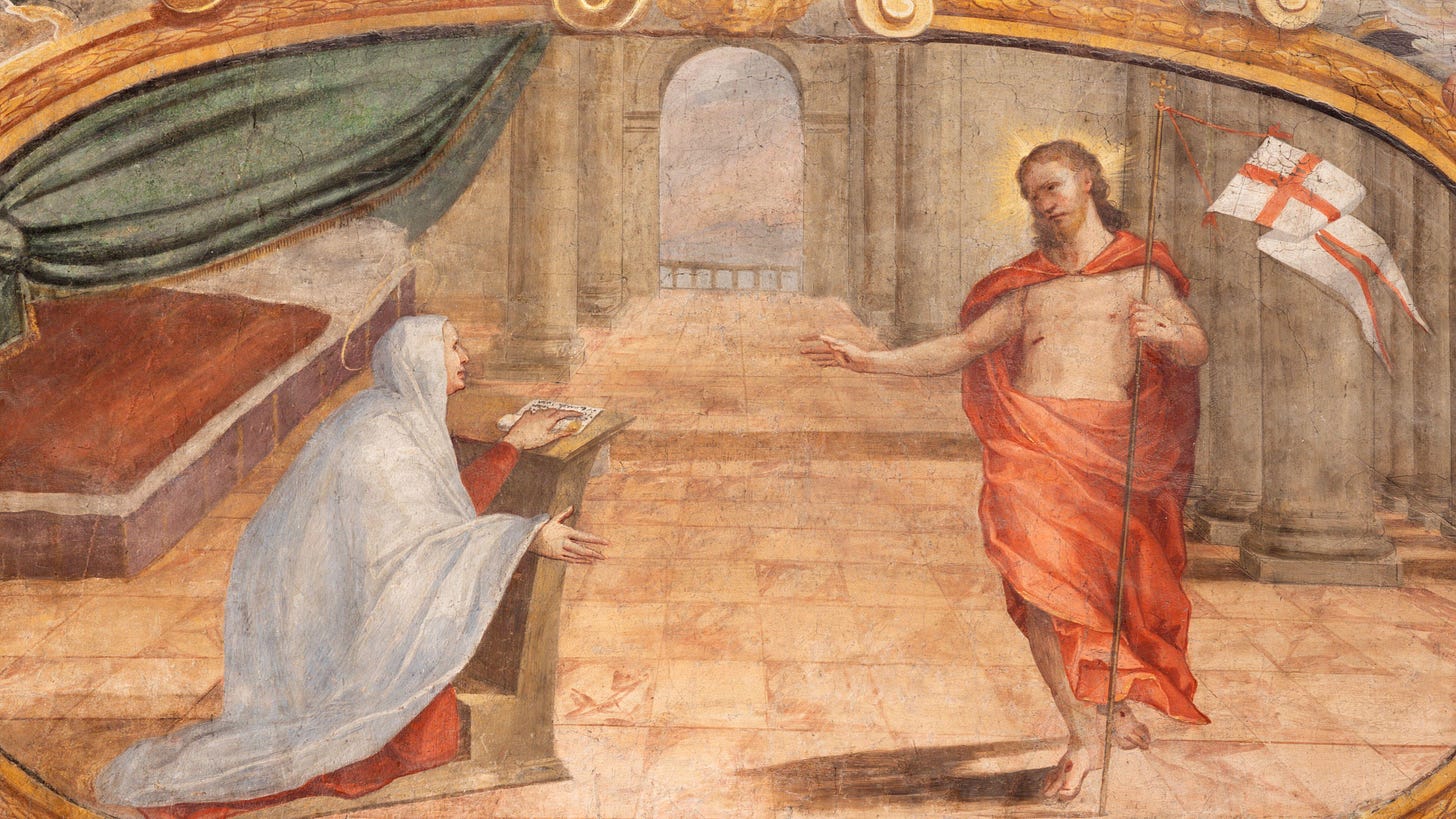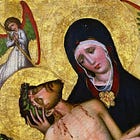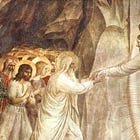What happened when Christ rose from the dead
Did Christ visit his mother first after his resurrection—and did he bring with him the saints from Limbo?

Did Christ visit his mother first after his resurrection—and did he bring with him the saints from Limbo?.
Editor’s Notes
In this Part, Fr. Coleridge tells us…
How the Resurrection revealed Christ’s dominion over death and inaugurated his eternal kingdom of glory.
That this victory was first manifested to his Blessed Mother and to the saints of Limbus, fulfilling divine justice and mercy.
Why the reunion of Christ and Our Lady is the most exalted moment of joy in all creation.
He shows us that Easter is not merely a return to life, but the beginning of immortal and beatifying communion with the risen Christ.
Christ visiting his mother first would be most fitting—leaving aside all notions of filial piety—given the unique role she played at the foot of the Cross, which you can read about below.
The Maccabean mother’s martyrdom and the link to Our Lady of Sorrows
Throughout his wonderful two-part work The Watches of the Sacred Passion, Fr Peter Gallwey SJ frequently returns to this idea, and applies the words of 2 Machabees to Our Blessed Mother:
“Now the mother was to be admired above measure, and worthy to be remembered by good men.”
Was Our Lady not also worthy of this privilege?
Easter Day
The Passage of Our Lord to the Father—Chapter XIV
St. Matt. xxviii. 2-15; St. Mark xvi. 2-13; St. Luke xxiv. 1-43; St. John xx. 1-29.
Story of the Gospels, § 173-177
Burns and Oates, London, 1892
Assumption of authority in the next world
In the last chapter we mentioned very briefly what all Christians believe, concerning the great assumption of power and authority on the part of the Sacred Soul of our Blessed Saviour, which we commonly speak of as His descent into Hell, in which He then took upon Him the sovereignty and dominion of the vast world of spirits.
We know how St. Paul afterwards dwelt on the connection, in the decrees of God, between the exaltation which followed on the Passion, and the humiliations which our Saviour had undergone on the Cross. We have said little enough about the movements and extent and rapidity of the way by which this marvellous Kingdom was enlarged over the immense numbers of subjects which now became its citizens, the entire homage which they paid Him, whether willingly or unwillingly, or the eternal rule which was then set up, the many various and different departments of His Kingdom, and the wonderful arrangements of justice and mercy which came into play therein.
It is enough to have hinted at a subject so vast, of which as yet we know little in detail. But the establishment of the rule over the world of spirits was but the first step to the further conquest, by which life and immortality were brought to light by the Saviour of the world.
Our Lady cognizant of our Lord’s triumph
The natural instincts of devout Christians lead them to believe that in some way or other, not known to us, the Blessed Mother of our Lord came to know of His triumph in the world below, when the myriads of blessed souls that were detained in hope in Limbus, flocked to greet Him, when the prisoners of the calm sufferings in Purgatory hailed Him as their deliverer, and when even the miserable souls in Hell became aware of His presence in the world of spirits, at least by its effects.
It is thought that our Lord remained in these lower regions, to cheer, in various ways, the happy souls there, till a few hours before the sunrise of Easter Day. What acts of mercy and justice He there performed to individual souls, we are not told, in the beatification of the saints, the remission of some pains to those souls who might still have had something unpaid of their debt, and the like.
Among them all, we are safe in supposing that His own dearest kindred and friends were not forgotten, St. Joseph, St. John Baptist, and others, those who had been most devout to His Person, and the good thief, who a few hours before had heard from His lips the promise that he should be that day with Him in Paradise.
Meanwhile, that Sacred Body of our Lord remained in the grave where it had been laid, adored by countless choirs of angels, though parted for the time from the Sacred Soul. The angels that watched the Sacred Body of our Lord in the tomb, may well be thought to have honoured also all that was yet to be found about the streets and the path along which He had moved, of fragments of the torn flesh and other relics, which were reassumed by Him after the Resurrection. This restoration of the Body of our Lord was not to be the work of any created power, such as may be supposed to have been that of the angels, but the effect of the Divine action of the Eternal Godhead, from which the Sacred Body itself was not in any respect separated during the hours of entombment, any more than the Soul of the Divine Person Who lay there in the grave.
Our Lord's Resurrection is sometimes spoken of in Scripture as the work of the Father, or the glory of the Father, and sometimes as the work of our Lord Himself, either statement being perfectly accurate. When the appointed time came, then, in an instant, the Body became reunited to the Soul, and woke up once more to life and to glory, which last it had by right possessed during its mortal life unused.
The great gifts of clarity, agility, and the others, were restored to it, though at times they were again suspended until the time of the Ascension and entrance into Heaven. We find our Lord using some of these gifts more habitually than others—as when He passed through the stone before it was removed from the sepulchre, when He entered the closed chamber in which the Apostles were assembled, though the doors were closed, and, in the same way, when He seems occasionally to have passed from place to place in a moment.
The saints from Limbus seeing the marks of the Passion
It is thought by Catholic writers that, before the Sacred Body rose again to life, some of the saints who were to accompany Him from Limbus were allowed to behold the marks of the Passion, and all that had to be traced in them, on that Sacred Body, in order that they might in this sense also look on Him Who had been pierced for the sins of the whole world.
This touching sight they may have been allowed in some way to share, even before the Resurrection. And it is much more easy to suppose that as soon as the Sacred Body resumed its fulness of life, at the moment of its reunion with the Soul, the saints who were already in possession of the Beatific Vision were allowed to enjoy the sight of the resuscitated Body. For it must be remembered that our Lord rose not only for Himself, but that His Resurrection was the renovation of the bodies of the whole race of mankind. St. Paul tells us that there will be a difference between the effects of the Resurrection in the different classes of men, and it seems well to suppose that the saints were then made aware that the boon of the Resurrection was in this way to be communicated to the bodies of the children of the Resurrection, as our Lord calls them.
Indeed, St. Matthew tells us, when he speaks of the prodigies which occurred after the Death of our Lord, that many bodies of the saints arose after His Resurrection, and appeared unto many, and went into the Holy City. An analogous wonder is thought to have occurred after the Ascension—that is, that both at the Resurrection and at the Ascension, our Lord rose and ascended, not alone, but accompanied by many of His saints. Something of the kind seems only to be reasonably expected on these great occasions.
Meeting of our Lady
It is not thought, as it seems, in the Church, that our Blessed Lady was actually an eye-witness of the Resurrection of our Lord, at the moment when it took place. But some holy writers have thought that at that time she was filled with a marvellous feeling of joyous and supernatural exultation, by which she was enabled to feel sure that her Son was risen.
No human imagination can soar to the joy with which she was inundated at the moment when He came fresh from the grave to make Himself visibly and sensibly present to her in her quiet chamber, where she had watched through the night in contemplation of what had passed and was passing with Him. It required, as we may surely say, all the wonderful strength and calm of that Blessed Mother to be able to meet the moment of their reunion. Before such wonderful outpourings of Divine love, we can only adore in silence. The joy of our Blessed Lady was, as the Scripture speaks, according to the multitude of the sorrows by which her Heart had been overwhelmed, and when the one can be measured, then also may the other be understood.
It was yet very early morning, perhaps before even the earthquake which drove away the Roman guards, and there was yet a considerable space of time before the care of the holy women who were so eager to pay our Lord the last offices of the unfinished embalmment, could call on Him to visit and encourage them. This was the time which our Lord seems to have given, as we find Him frequently during those forty days of the Resurrection, to converse with His Blessed Mother.
After a time, it is thought, that He would present to her the happy souls whom He had just made partakers of His glory in Limbus, and in them the new spoils, so to call them, of His victory over Death and of His Resurrection. As her intelligence of Scripture and of the ways of God was so great and perfect, she could understand, in each one of these glorified souls, how wonderful had been His goodness, His patience, His power, His mercy, and how each one of them had been the faithful worker with grace which had flowed from Him.
She saw before her the saints and heroes, the prophets and kings, those who in their own history had foretold Him and herself in type or prophecy—her own dearest parents, her own beloved spouse, and the Blessed John.
Great intelligence of the saints
In the language of one of the apostolic descriptions of the blessedness which awaits us in Heaven, it is said, as the crown and consummation of all that bliss, that Christ shall be all in all. The loveliness of the saintly character, as it is to be seen in the multifarious variety and beauty of the saints, is not a simple repetition in each one of the same charms and graces, but there is an endless newness among the inexhaustible beauties on which the blessed will feast for ever, without being satiated or wearied.
The foundation of each saintly character is in its resemblance to our Lord, and the beauties are ever varied. And in thinking of the happiness which each one will enjoy in each other, it must be remembered that we speak of souls endowed with most marvellous faculties, both of intelligence and of enjoyment, so that all will be able to see, in the sharers of their felicity, more than can be imagined here, where all our faculties of intelligence and happiness are dulled and stunted and dwarfed by the fetters of the corruptible body.
It is easy, therefore, to see that we are here thinking of a state of happiness and delight of which we cannot at present form any adequate conception. To live, even now, in the companionship of some one or two very holy persons, is enough to transfer the persons who possess that blessing into something that almost resembles a new state of existence, and it is easy to see that the intercourse which will be the chief delight of the saints with God our Lord, the saints, the angels, and one another, will be too full of enchanting delights to be fathomed by any one of us in this temporal prison.
This new state of happiness now began for the saints who entered on the Beatific Vision, at the time of which we are speaking, and has gone on increasing in intensity and largeness as the company of the blessed increases in number and beauty, as time passes on. But when we speak of the meeting and reunion between our Lord and His Blessed Mother, we touch upon joys and glories by the side of which the very brightest and deepest of heavenly transports seem to fade to nothing.
Subscribe to never miss an article:
Read Next:
The Maccabean mother’s martyrdom and the link to Our Lady of Sorrows
Here’s why you should subscribe to The Father Coleridge Reader and share with others:
Fr Coleridge provides solid explanations of the entirety of the Gospel
His work is full of doctrine and piety, and is highly credible
He gives a clear trajectory of the life of Christ, its drama and all its stages—increasing our appreciation and admiration for the God-Man.
If more Catholics knew about works like Coleridge’s, then other works based on sentimentality and dubious private revelations would be much less attractive.
But sourcing and curating the texts, cleaning up scans, and editing them for online reading is a labour of love, and takes a lot of time.
Will you lend us a hand and hit subscribe?
Follow our projects on Twitter, YouTube and Telegram:





